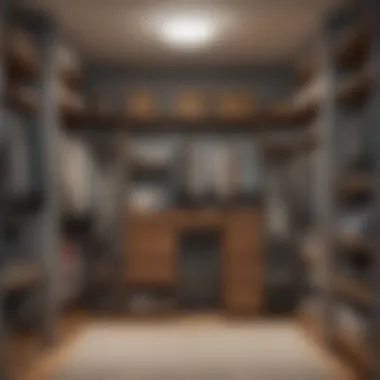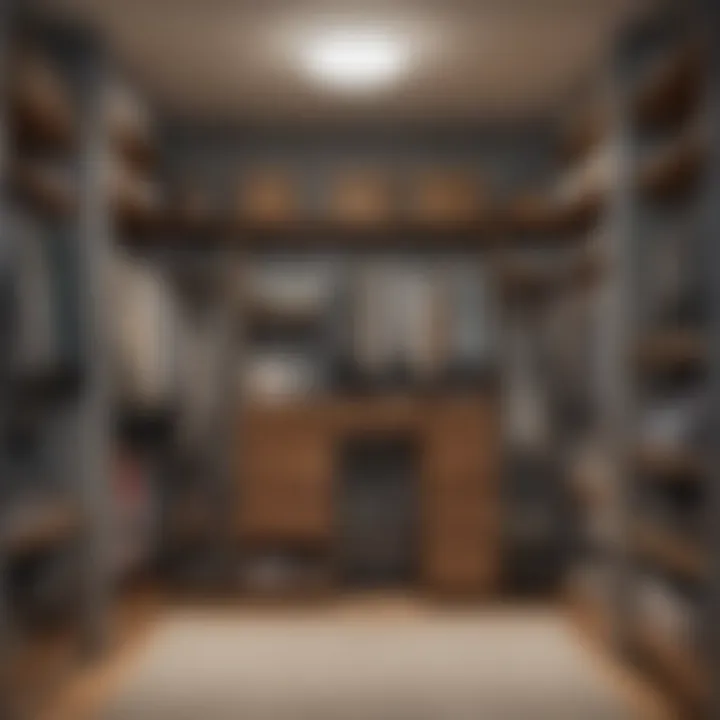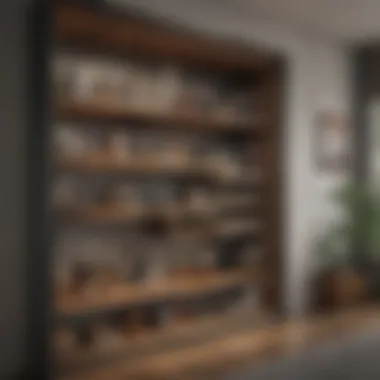Maximizing Small Closet Storage with Smart Shelving


Intro
Small closets present unique challenges for homeowners and apartment dwellers alike. The demand for efficient storage solutions becomes critical when space is at a premium. This articel takes a closer look at optimizing small closet storage shelves. By focusing on organized strategies, this guide aims to help readers make the most out of their limited space while maintaining a chic and orderly appearance.
Exquisite Architectural Designs
When it comes to designing small closets, architectural choices play a vital role. Thoughtful designs can create a harmonious balance between aesthetics and functionality. Here, we explore various design elements that can enhance the experience of using storage spaces.
Unique Home Features
Many homes feature distinct architectural traits that can influence the effectiveness of closet storage. For instance, an angled ceiling or unusual layout can limit options. However, these unique features can also inspire creative solutions. Custom-built shelves, for instance, can follow the lines of the space, ensuring no area goes unused.
- Consider utilizing corner shelves to maximize awkward areas.
- Wall-mounted options can free up floor space.
Historical Significance
Closets in older homes may present specific materials and designs that reflect the architectural style of their time. Understanding these elements is crucial. For example, a Victorian home might feature ornate wood shelves, while Modernist spaces may opt for sleek metal structures. Enhancing these original designs can create a blend of old and new that is both functional and visually appealing.
Interior Decorating Tips
The visual aspect of a small closet often gets overlooked. Focusing on decor can elevate this space. Here are several effective tips to consider.
Color Schemes and Trends
Choosing the right color scheme is essential. Lighter colors can create an illusion of more space. Soft pastels or whites help amplify natural light. Dark colors, while bold, can sometimes work in smaller doses, such as accent shelves or bins.
- Neutral palettes keep the area clean and inviting.
- Adding pops of color through accessories can bring life to the space.
Space Optimization Techniques
Maximizing storage means taking full advantage of available height and depth. Some techniques include:
- Adjustable shelving: This allows for flexibility as your storage needs change.
- Drawer dividers: These help categorize items, making them easy to access.
- Storage bins: Utilizing labeled bins not only keeps things tidy but also enhances visual organization.
"A well-organized closet reflects personal style while catering to practicality."
End
By understanding the principles of design and effective space management, anyone can optimize their small closet storage. The right combination of architectural awareness and innovative decorating solutions can transform a challenging area into a functional and attractive storage space.
Understanding Small Closet Dynamics
Creating an efficient small closet relies heavily on understanding its dynamics. Small closets often face unique challenges due to their limited size and capacity. Knowing how to navigate these hurdles can make all the difference in maximizing storage efficacy. The primary aim of this section is to uncover the intricate relationships between design strategies and practical storage solutions.
The Role of Storage Shelves
Storage shelves serve as a fundamental component in small closets. They enhance organization by not only providing a place for items but also optimizing vertical space. By utilizing shelving systems, one can transform cluttered closets into well-structured areas. Enhanced organization leads to quicker access to essentials. This efficiency is particularly valuable in today’s fast-paced environment.
- Accessibility: Proper shelving allows for items to be found easily, reducing time spent searching for stored goods.
- Maximized Space: Overflowing floors can appear chaotic. Shelves help utilize vertical areas effectively, allowing for more items to be stored in a neat manner.
- Flexibility: With options such as adjustable and floating shelves, users can adapt the organization based on changing needs.
Defining Closet Space Limitations
Understanding the limitations of closet space is crucial for optimizing its usage. Small closets often present conflicting priorities; what may seem essential can easily become overwhelming when every inch counts. In defining these limitations, several factors come into play:
- Dimensions: Actual measurements of height, width, and depth guide decisions on shelving types.
- Accessibility: How frequently items are needed dictates where they should be placed. High shelves may hold seasonal items, whereas everyday essentials occupy lower shelves.
- Weight Capacity: This is an often overlooked consideration. Overloading shelves can lead to safety hazards and damage. Hence, it is important to assess the weight distribution carefully.
By understanding these elements, individuals can make informed decisions that lead to a more functional closet.
Understanding both the dynamics at play within the closet and the role of shelving significantly enhances the efficiency of space utilization.
Types of Storage Shelves for Small Closets
When it comes to optimizing small closet storage, the selection of shelving is critical. The right type of shelf can transform a cramped space into an organized haven. Different shelving options not only influence the aesthetics of a closet but also its functionality. Selecting the correct shelving can enhance the usability of the closet, allowing for easier access to items. Each option carries unique benefits, catering to varied needs based on the closet's dimensions, items stored, and personal organization preferences.
Adjustable Shelving Systems
Adjustable shelving systems provide versatility in storage. Homeowners can modify the height of shelves based on specific requirements, accommodating different sized items. This flexibility is particularly useful in spaces that serve multiple purposes. For instance, if seasonal clothing is stored in the same closet as sports equipment, adjustable shelves can easily accommodate both.


A well-designed adjustable shelving system also promotes the utilization of vertical space, critical in smaller closets. By arranging shelves at various heights, one can optimize the distance between them to suit each type of item, minimizing wasted space. These systems come in a variety of materials, appealing to diverse aesthetics and budgets. Therefore, one can choose a metal adjustable shelving unit for a modern look or a wooden system for warmth.
Floating Shelves
Floating shelves are ideal for maximizing wall space without consuming floor area. They create an illusion of a larger room, contributing to a more open feel. Installation is straightforward, and most floating shelves support significant weight, making them suitable for boxes and decorative items alike.
Another advantage of floating shelves is their design flexibility. They can be arranged in patterns or installed in staggered placements to create visual interest. This creativity can be particularly appealing to those interested in showcasing collectibles or personal items. However, careful planning is necessary to ensure proper weight distribution and stability, avoiding a cluttered look.
Corner Shelves
Utilizing corners often overlooked in closet design is essential. Corner shelves fit snugly into those awkward angles, transforming underutilized space into valuable storage. This style is especially beneficial in small closets where every inch counts.
Corner shelves can be designed to hold various items, from shoes to bags and other closet essentials. They are also available in various configurations, allowing them to blend seamlessly with existing shelving. When integrated correctly, they improve the overall storage capacity of a closet while maintaining a tidy appearance.
Built-in Shelving Options
Built-in shelving options provide a seamless, custom solution for small closets. These shelves are designed to fit the particular measurements of the closet, maximizing every available inch. Built-in shelves can be constructed in various styles, from high-end cabinetry to simpler plywood designs.
Aside from their perfect fit, built-in shelving has the benefit of increasing overall property value. When potential buyers see customized, well-organized closets, they imagine themselves living comfortably in the space. Additionally, built-ins can be engineered with pull-out sections, drawers, and hidden compartments to make the most of storage within tightly confined areas.
Optimizing storage in small closets requires thoughtful consideration of shelf types. Understanding their unique benefits allows homeowners to make informed choices tailored to their specific storage needs. Evaluating options like adjustable shelving systems, floating shelves, corner units, and built-ins can lead to a more organized and aesthetically pleasing space.
Materials for Closet Shelving
Choosing the right materials for closet shelving is crucial for optimizing space and ensuring functionality. The material you select impacts not only the strength and durability of the shelves but also their aesthetic appeal and maintenance requirements. Understanding the various material options can lead to more informed decisions that align with your specific needs and budget.
Good shelving can accommodate various items, from shoes to folded clothes and accessories. The materials you choose dictate how the shelves will perform over time, how much weight they can hold, and how they will fit within your closet's design.
The following sections discuss three prevalent materials used in closet shelving: wood, metal, and plastic.
Wood: A Classic Choice
Wood has long been the go-to option for closet shelving due to its natural aesthetics and versatility. It seamlessly integrates into various interior design styles, from traditional to modern. One of the key benefits of wood shelving is its strength; it can support heavy items without bowing or sagging, especially when constructed from hardwoods like oak or maple.
Additionally, wood can be stained or painted to match your existing decor, enhancing the overall look of your space. There are several types of wood to consider, including:
- Plywood: Cost-effective and sturdy, suitable for budget-friendly options.
- Solid Wood: Offers a beautiful finish and longevity, but comes at a higher price.
- MDF (Medium-Density Fiberboard): A cheaper alternative that can be painted or veneered; however, it is less durable under heavy loads.
With proper care, wood shelves can last for many years. It's essential to avoid exposing them to excessive moisture, which can lead to warping or damage.
Metal Shelves for Durability
Metal shelves present an excellent choice for those looking for durability and strength. Typically constructed from steel or aluminum, they offer high resistance to wear and tear. They are less prone to bending under weight and can accommodate heavy items, making them suitable for tools or heavier clothing.
Moreover, metal shelving often comes with various finishes, such as chrome or powder-coated options, allowing for some aesthetic flexibility. This type of shelving is particularly well-suited for:
- Humidity-Prone Areas: Unlike wood, metal does not absorb moisture, making it ideal for closets that may experience fluctuations in humidity.
- Commercial Spaces: Businesses often favor metal shelving for their strength and easy maintenance.
Despite their benefits, metal shelves can lose their shine over time and may require polishing to maintain their appearance. Additionally, they usually lack the warmth of wood, making them less suitable for all design aesthetics.
Plastic and Composite Materials
Plastic and composite materials provide a lightweight alternative to both wood and metal shelves. They are often made from high-density polyethylene or similar materials that are easy to clean and resistant to stains and spills. This makes them ideal for organizing closets in a family home where spills or dirt may occur.
Composite shelving, often produced from a blend of particle board and resin, replicates the look of wood at a lower cost. Some considerations when thinking about plastic shelving are:
- Lightweight: Easy to install and adjust; a significant advantage when you may want to reconfigure your closet setup.
- Budget-Friendly: Typically less expensive than solid wood or metal options.
- Limited Load-Bearing Capacity: While they suit lighter items well, care should be taken not to overload them.
Choosing the right material depends on your needs, the weight of items you intend to store, and your aesthetic preferences. Each material offers distinct advantages and limitations that cater to different contexts and styles.
"Appropriate material selection is essential for ensuring the longevity and functionality of closet shelving."
As you contemplate the materials for your closet shelving, consider how they will serve your specific requirements while contributing to the overall design of your space.
Design Considerations for Small Closets
Design choices play a critical role in the functionality and aesthetic of small closets. When optimizing these spaces, several factors should be considered. The key is to utilize the available area efficiently while ensuring it meets both storage needs and visual appeal.
The importance of effective design cannot be overstated. It determines how well you can navigate the space and access items when needed. A well-thought-out design approach not only maximizes storage but also enhances the experience of using the closet. The following aspects can greatly influence the overall outcome.


Maximizing Vertical Space
In small closets, floor space is often limited. Therefore, utilizing vertical space becomes essential. Shelving that reaches near the ceiling allows for the storage of items that are not frequently used. This can include seasonal clothing, luggage, or other infrequently accessed items.
Wall-mounted units and tall shelving systems can help take advantage of unused vertical height. Depending on the configuration, consider adjustable shelves that can be tailored over time as your storage needs change. Another option is to add hooks or pegboards along the walls for hanging accessories, bags, or jewelry, further utilizing the vertical potential.
Utilizing Depth Wisely
The depth of a closet can significantly enhance its storage capacity. Standard shelving can often be deep, leaving the back sections hard to access or unusable. Use shallow shelves for easy visibility and access. Additionally, consider organizing deeper spaces with pull-out drawers or bins. This method allows for easier retrieval of items stuck at the back and can help prevent overfilling.
In smaller areas, it may be wise to employ tiered shelving or sliding systems that bring items forward as they are needed. Ensuring that every inch of depth counts can lead to a more organized and efficient closet system.
Color Schemes and Visual Perception
The colors used in a closet can impact how spacious it feels. Lighter shades, such as whites or pastels, can create an illusion of openness. Dark colors, while stylish, often make the space feel smaller and more confined.
Consider incorporating mirrors as part of the design. Mirrors reflect light and can create a sense of depth. They can also add an element of sophistication to the closet. When selecting colors, look not only for personal preference but also for how they affect light and space.
Ultimately, effective design for small closets revolves around creating balance among maximizing storage, managing space utilization, and considering visual impact. Ensuring that these elements are in harmony can lead to a functional and appealing storage solution.*
"Designing small closets effectively transforms how these spaces serve their purpose and influence overall home organization."
By focusing on these design considerations, one can achieve a well-organized and visually appealing small closet. Each element contributes to enhancing both function and aesthetics, making it easier to find and store belongings.
Effective Organization Techniques
Effective organization techniques are crucial in optimizing small closet storage spaces. A well-organized closet can save time, reduce stress, and enhance accessibility. When everything has a designated spot, it becomes easier to find items when needed. These techniques transform chaos into order, making it possible to utilize limited space fully. Furthermore, thoughtful organization helps in maintaining neatness over time, as items are less likely to be misplaced.
Categorizing Items for Efficiency
Categorizing items is a key strategy in ensuring efficiency within small closets. Start by dividing belongings into specific groups based on usage, type, or season. For example, keep clothing items like shirts, coats, and accessories together. Similarly, shoes can have their own section. This approach not only makes retrieval easier but also encourages you to assess what you have and what you need. Sorting items into clear categories reduces the time spent rummaging through the closet and provides a visual cue to help maintain order.
Using Baskets and Containers
Incorporating baskets and containers can significantly enhance the organization of small closet shelves. These tools provide a neat solution for grouping smaller items that might otherwise scatter. Baskets are ideal for casual storage, while more structured containers work well for heavier or delicate items. Opt for consistent sizes and styles to create a harmonious look. This can also offer a streamlined visual effect, making the closet appear less cluttered. You can even label baskets to identify contents quickly without the need to dig through them, optimizing accessibility further.
Labeling for Quick Access
Labeling is an often-overlooked but effective method for achieving quick access to items in your closet. By using clear labels, you can enhance the functionality of your storage space. Labels can be attached to baskets, shelves, and containers to provide instant insight into what is stored where. This eliminates guesswork and streamlines the process of locating items. Consider using a label maker or simple handwritten tags on sturdy materials to ensure their durability. An organized label system contributes to a more user-friendly environment, making it easy for anyone to find what they need.
"An organized closet is not just about storage, it’s about finding joy in simplicity."
Custom Solutions for Unique Spaces
Custom solutions for unique spaces are crucial when it comes to optimizing small closet storage. Every home has its distinct quirks, whether it is an odd shape or varying height. Recognizing this, customizing storage systems ensures that you make full use of available space. A well-planned shelving system can bring order to chaos and enhance accessibility, which is vital in small areas.
Tailoring Shelving Systems to Your Needs
When it comes to tailoring shelving systems, the first step is to assess your specific requirements. Begin by listing items you plan to store. Different items have different dimensions and weights, which influence the shelf type you should select.
- Would adjustable shelves be more useful for a diverse range of items?
- Should you opt for narrow or deep shelving based on the closet's layout?
Recognizing your needs will allow you to choose suitable materials and designs. For instance, heavier items necessitate sturdy materials like solid wood or metal. Conversely, lighter goods may do fine with plastic materials that save some weight. By focusing on your unique requirements, you can create a cohesive and functional shelving system.
Consulting with Professionals
Consulting with professionals can significantly enhance the outcome of your closet optimization project. Interior designers and professional organizers often bring a wealth of experience. They can provide insights that may not be apparent to a layperson.
Engaging professionals allows for a thorough evaluation of your space. They can recommend strategic solutions tailored to your specific constraints and storage needs. Moreover, they stay updated on trends and techniques within the realm of closet design. This expertise can lead to innovative solutions, saving you time and money in the long run.
Some professionals also have access to custom shelving options that are not readily available to the general public. This can be an advantage when working with narrow or uniquely formed closets. In many cases, the investment pays off through better organization, functionality, and even an increase in property value over time.
Custom solutions empower homeowners to maximize their spaces while ensuring everything is organized and easily accessible.
Incorporating Technology in Closet Design
The integration of technology into closet design is becoming increasingly important for optimizing storage solutions. As living spaces become smaller, the need for effective and efficient organization rises. Modern technology offers innovative ways to maximize usability in small closets, providing both functionality and a seamless user experience.


By embracing technological advancements, homeowners can manage their storage more effectively. Smart shelving solutions and various applications can streamline the way one organizes and accesses items. These not only save time but also reduce frustration when searching for items. Keeping closets organized through tech allows individuals to make the most of their limited space without sacrificing style or accessibility.
Smart Shelving Solutions
Smart shelving solutions are designed to enhance flexibility and accessibility in closet spaces. For instance, adjustable shelves that can be repositioned easily can accommodate different types of items, from shoes to folded clothes. Some smart systems integrate sensors that monitor the weight of stored items. This ensures shelving remains safe and usable, reducing the risk of accidents.
These systems often come with built-in lighting that illuminates dark closet corners, making it easier to locate items quickly. Furthermore, there are smart shelving units that can be controlled via smartphones, enabling users to manage their storage environments remotely. Including integrated charging ports for devices on shelves can also facilitate a tech-friendly environment, which appeals to many homeowners today.
- Benefits of smart shelving solutions:
- Flexibility in layout and use
- Enhanced safety features
- Remote accessibility for convenient management
Apps for Closet Management
The rise of mobile applications dedicated to closet management represents a significant advancement in organizing small spaces. These apps allow users to catalog their wardrobe, visualize outfit combinations, and keep track of which items are in the closet. By having a digital inventory, individuals can avoid purchasing duplicate items, thus maximizing their investment in clothing and accessories.
Apps can facilitate seasonal rotation of clothing, assisting users in switching out attire based on current needs or trends. Some applications even offer suggestions on how to pair items based on individual preferences. The convenience of having a visual aid through their phones can significantly reduce the time spent looking for outfits. This tech-savvy approach not only enhances organization but also contributes to a more efficient morning routine.
"Incorporating technology into closet design can transform chaos into harmony."
Also, syncing apps with social media accounts allows users to share their styles and seek inspiration beyond their immediate closet. These features can make closet management an engaging and creative process while addressing the challenges posed by limited space.
Maintenance and Upkeep of Storage Shelves
Maintaining and managing storage shelves effectively can substantially enhance the lifespan and functionality of a closet. Every time a closet is used, whether for everyday items or seasonal storage, its shelves are put under stress. Ongoing maintenance ensures that the components remain strong, organized, and visually appealing.
Adopting a regular maintenance routine offers several benefits. First, it prevents wear and tear that can lead to accidents, such as collapsed shelves. Second, a clean and organized closet improves accessibility and usability, making it easier to find what you need when you need it. Moreover, regular upkeep can reveal problems before they become significant issues, saving both time and money in the long run. Considerations for maintenance include cleaning techniques and scheduling regular inspections.
"A well-maintained shelf not only serves its purpose but also enhances the entire closet experience."
Cleaning Techniques
Cleaning is a fundamental aspect of shelf maintenance. Dust and dirt can build up quickly, especially in small spaces where air circulation is limited. Fortunately, effective cleaning does not require specialized equipment or products. Here are some helpful cleaning techniques:
- Dust regularly: Use a microfiber cloth to remove dust and debris from shelves. Doing this weekly prevents buildup and keeps items clean.
- Use mild detergents: For sticky or stained areas, combine water with a gentle detergent. A soft sponge can lift stubborn residues without damaging the shelf material.
- Avoid moisture: Ensure not to use excess water when cleaning, as it can warp wood or rust metal. Wipe down surfaces with a slightly damp cloth, then dry immediately.
- Assess items: While cleaning, take time to assess what is on the shelves. This is a good opportunity to declutter and reorganize items, maintaining only what is necessary.
Implementing these techniques fosters a cleaner and healthier storage environment.
Regular Inspections for Longevity
Alongside cleaning, routine inspections are vital for ensuring the longevity of your closet shelves. A systematic approach to checking the state of the shelves can help identify problems before they escalate. Consider these points during inspections:
- Check for stability: Monthly, verify that the shelves are level and securely mounted. Uneven shelves can cause items to slide off or get damaged.
- Look for signs of damage: Regularly inspect for any cracks, warping, or deterioration. Wooden shelves may develop splits, while metal shelves might show signs of rust.
- Assess weight capacity: Ensure that items stored on the shelves do not exceed their weight limits. Overloading can compromise structural integrity and safety.
- Reassess organization: During each inspection, assess how items are organized. This can lead to more efficient usage and an opportunity to further declutter as necessary.
Integrating these inspection practices into your routine not only helps maintain functionality but also contributes to a more pleasant and organized closet space.
The Future of Closet Design
The evolution of closet designs reflects broader shifts in lifestyle and preferences. As urban living spaces get smaller, the future of closet design is increasingly focused on optimizing space without sacrificing style. This article underscores the importance of revisiting traditional storage concepts in light of these developments. Understanding the importance of modern design principles and their impact on daily life is essential for anyone looking to enhance their storage solutions.
Emerging Trends in Minimalism
Minimalism stands as a hallmark of modern design philosophy. This trend emphasizes simplicity, functionality, and decluttered spaces. For closet design, minimalism means adopting streamlined shelves, discreet storage options, and clean lines. It advocates for choosing quality over quantity, leading to fewer, yet more meaningful, items in the closet.
- Benefits of Minimalism:
- Enhances visual clarity, making small spaces feel larger.
- Facilitates easy access and organization, minimizing chaos.
- Promotes sustainable living by encouraging the purchase of fewer, higher-quality items.
Minimalist design strategies include:
- Using neutral colors to create an airy feel.
- Selecting storage solutions that blend seamlessly into the existing decor.
- Employing multifunctional furniture that can serve dual purposes, such as an ottoman that also acts as storage.
This shift towards minimalism not only serves aesthetic preferences but also aligns with a growing desire for efficient living.
Sustainable Materials and Practices
Sustainability in design is no longer just an option; it is a necessity that reflects a collective responsibility towards the environment. In closet design, this translates to using eco-friendly materials and implementing sustainable practices. Choosing sustainable materials such as bamboo, reclaimed wood, or recycled metal not only reduces environmental impact but also adds unique charm to the closet.
- Key Considerations for Sustainable Closet Design:
- Longevity: Select sturdy materials that reduce the need for frequent replacements.
- Resource Efficiency: Opt for products manufactured with minimal waste and energy consumption.
- Local Sourcing: Where possible, choose locally sourced materials to reduce transportation emissions.
"Sustainable design is not just a trend; it's a future direction for all forms of architecture and interior design."
Adopting these practises creates an inviting atmosphere while demonstrating commitment to sustainability. Integrating such elements means being conscious of choices and their potential impact over time, paving the way for closets that are not only beautiful but also responsible.















